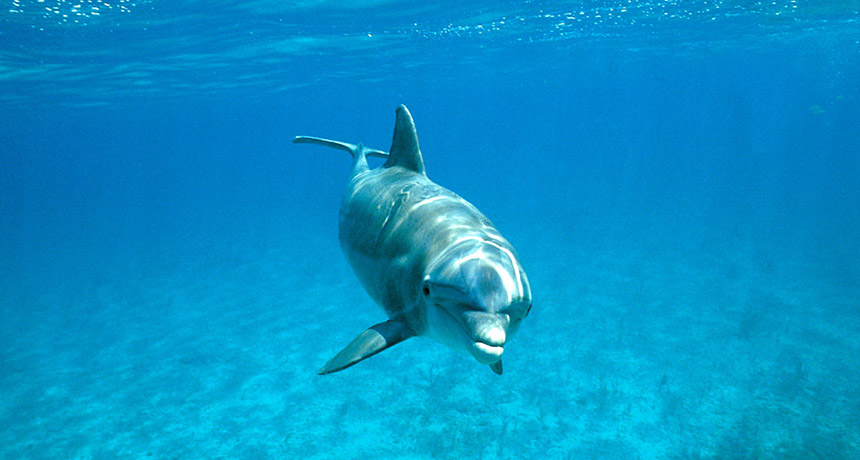Snot may be key to dolphins’ tracking of prey
The mucus may play pivotal role in the animals’ echolocation system

Dolphins make chirpy clicking noises that act like sonar to find prey. Mucus may help these animals’ make those all-important clicks, new data suggest.
sheilapic76/Flickr (CC BY 2.0)
In hunting down lunch, Flipper may have a secret weapon: snot.
Dolphins employ the animal equivalent of sonar to find and track their prey. To do this, they emit a series of quick, high-frequency sounds. Biologists suspect the marine mammals make these chirp-like clicks by forcing air over tissues in their nasal passages. “It’s kind of like making a raspberry,” explains Aaron Thode. He studies marine-mammal sounds — acoustics (Ah-KOO-stiks) — at the Scripps Institution of Oceanography in San Diego, Calif.
Thode and his team tweaked a technique used to model human speech so that they could mimic dolphin sounds in the lab using a computer. They were looking to explore how these small whales go about their unique way of making sound. And nasal mucus — snot — now appears key, their data show.
Thode presented his group’s new findings May 24 in Salt Lake City, Utah. It took place at the annual meeting of the Acoustical Society of America.
Dolphin clicks have two parts: a thump and a ring. Their model worked on the assumption that lumps of tissue bump together to make the thump. They guessed that the ringing sound occurred when those tissues pulled apart. But to mimic in the lab those high frequency sounds that live bottlenose dolphins make, the researchers had to make surfaces on the nasal passages sticky. That suggests that the mucus lining these passages is key to dolphin sonar.
The vocal model also mimicked whistling noises that dolphins use to communicate with each other. It similarly modeled faulty clicks. These last sounds are likely due to inadequate snot.
Such findings could be used to help probe sound production and echolocation in sperm whales and other dolphin relatives.
Power Words
(for more about Power Words, click here)
acoustics The science related to sounds and hearing.
bottlenose dolphin A common species of dolphin (Tursiops truncate), which belongs to the order Cetacea among marine mammals. These dolphins are found all over the world.
dolphins A highly intelligent group of marine mammals that belong to the toothed-whale family. Members of this group include orcas (killer whales), pilot whales and bottlenose dolphins.
echolocation (in animals) A behavior in which animals emit calls and then listen to the echoes that bounce back off of solid things in the environment. This behavior can be used to navigate and to find food or mates. It is the biological analog of the sonar used by submarines.
frequency The number of times a specified periodic phenomenon occurs within a specified time interval. (In physics) The number of wavelengths that occurs over a particular interval of time.
mammal A warm-blooded animal distinguished by the possession of hair or fur, the secretion of milk by females for feeding the young, and (typically) the bearing of live young.
model A simulation of a real-world event (usually using a computer) that has been developed to predict one or more likely outcomes.
marine Having to do with the ocean world or environment.
nasal Having to do with the nose.
oceanography (adj. oceanographic) The branch of science that deals with the physical and biological properties and phenomena of the oceans.
prey (n.) Animal species eaten by others. (v.) To attack and eat another species.
sonar A system for the detection of objects and for measuring the depth of water. It works by emitting sound pulses and measuring how long it takes the echoes to return.
sperm whale A species of enormous whale with small eyes and a small jaw in a squarish head that takes up 40 percent of its body. Their bodies can span 13 to 18 meters (43 to 60 feet), with adult males being at the bigger end of that range. These are the deepest diving of marine mammals, reaching depths of 1,000 meters (3,280 feet) or more. They can stay below the water for up to an hour at a time in search of food, mostly giant squids.
tissue Any of the distinct types of material, comprised of cells, which make up animals, plants or fungi. Cells within a tissue work as a unit to perform a particular function in living organisms. Different organs of the human body, for instance, often are made from many different types of tissues. And brain tissue will be very different from bone or heart tissue.
unique Something that is unlike anything else; the only one of its kind.







